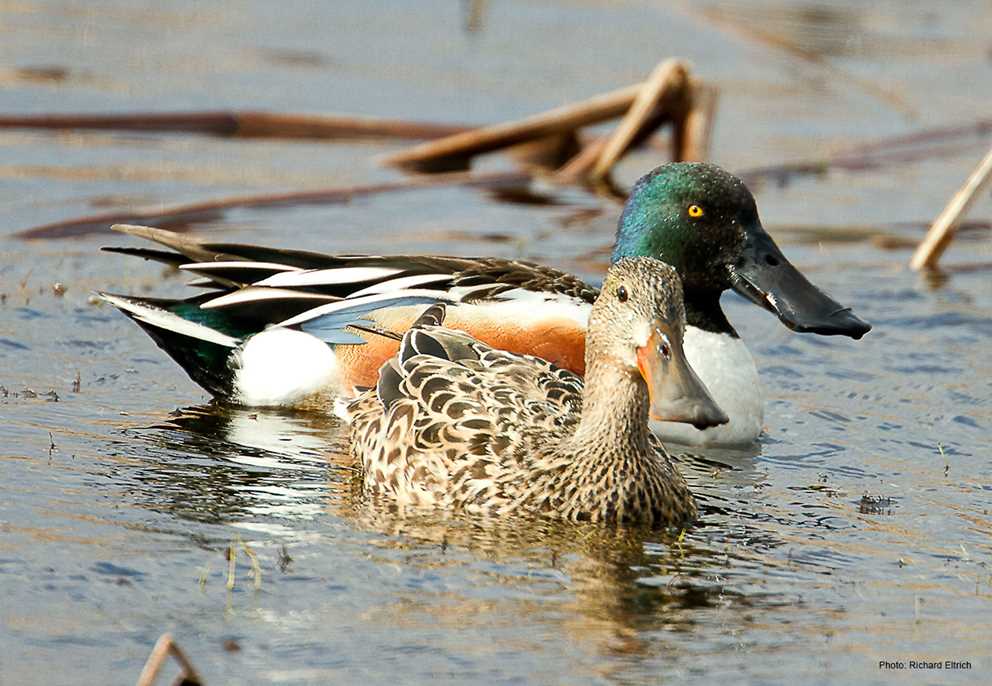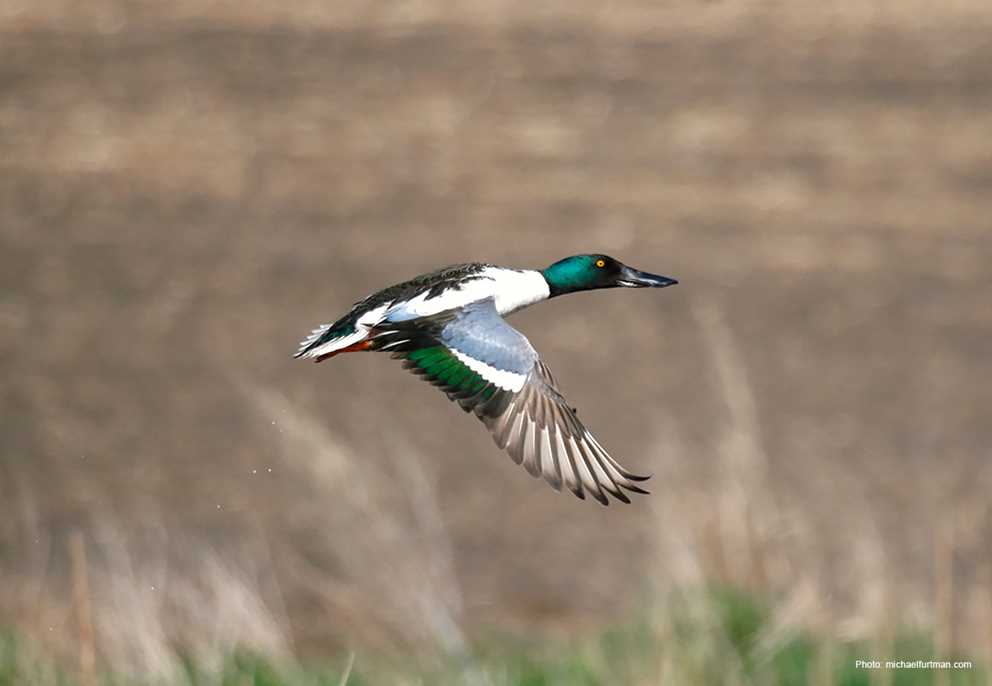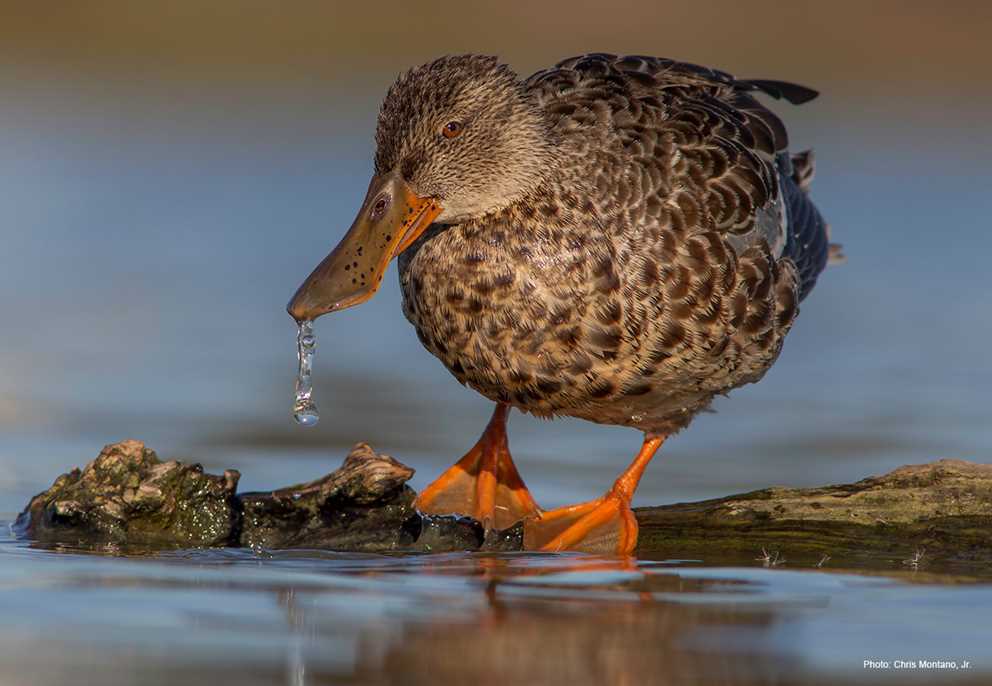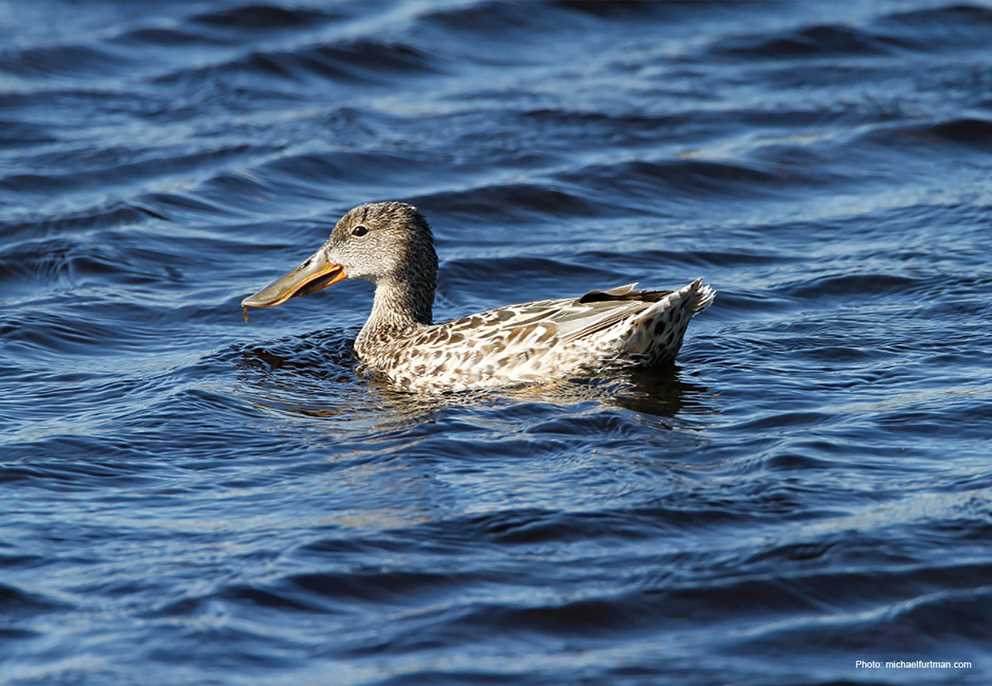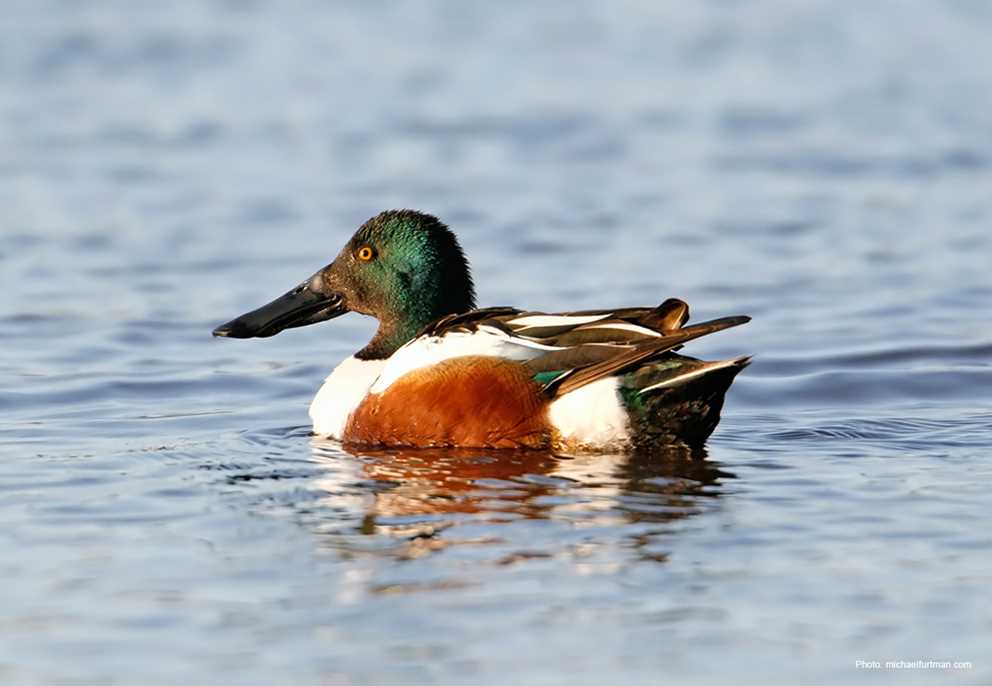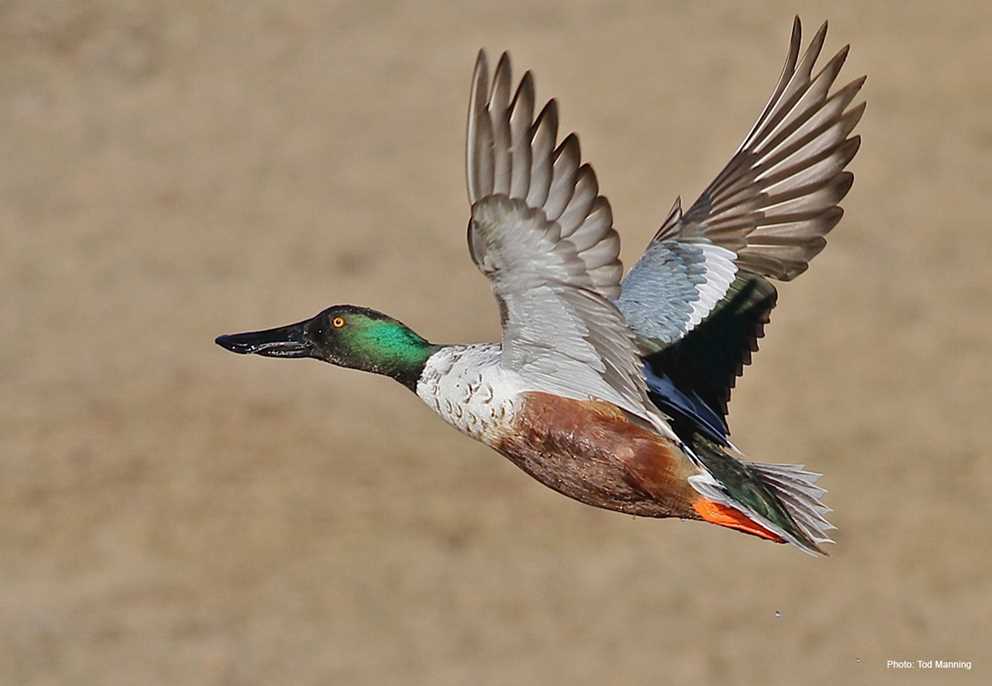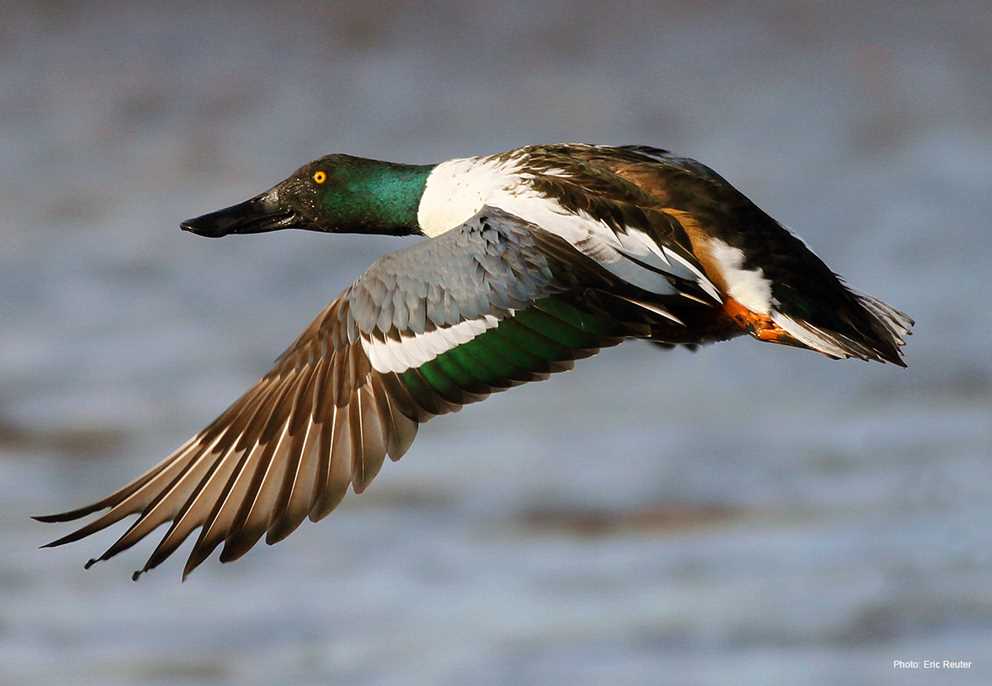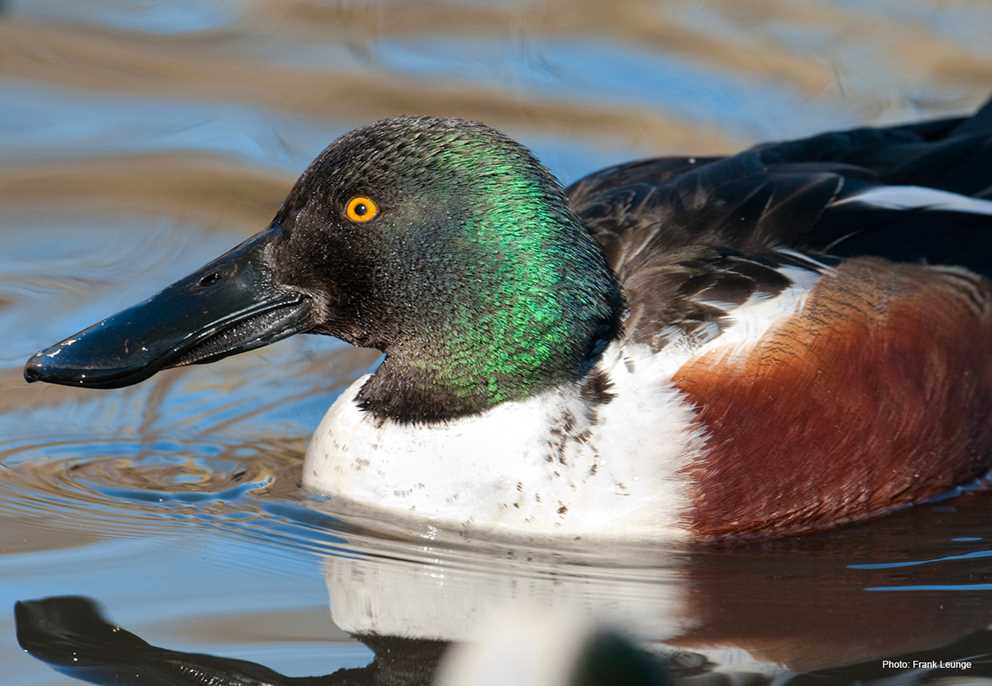Overview
The Northern Shoveler is a medium sized dabbling duck with a circumpolar distribution. In North America, their breeding range extends from Alaska to northeastern Manitoba, and from Washington east through the Intermountain West and Great Plains. The core of the breeding range is in the Prairie Pothole Region of Canada and the United States. Their winter range extends from the southern United States, through Central America, to South America from Colombia to Venezuela, and includes most Caribbean Islands. Northern Shovelers predominantly use freshwater wetlands throughout their range, though in coastal areas they also use brackish wetlands.
Northern Shovelers are named for their spatulate shaped bill for filtering small crustaceans from the water column. Both sexes have a powder blue wing patch on their upper wing, but it is much brighter in males. Males in alternate plumage have a dark green head and neck, notable black spatulate bill, white chest and breast, chestnut-brown sides, a white flank spot in front of the black rump and vent. The speculum is iridescent green with a bold white anterior border. The intensity of the blue wing patch and absence of brown in the secondary coverts is useful to separate them from females. Females are mottled brownish gray overall. The head is somewhat lighter brown and has a dark eye stripe. The bill is dusky orange, and the legs and feet are pale orange.
Description
Key Identification Features:
- Northern Shovelers have a large spatulate bill which is black in males and dusky orange in females. Both sexes have a powder blue wing patch, but it is duller in females. Iris color is yellow in males, brown in females.
- Males in alternate plumage have a dark green head and neck, white breast, chestnut-brown sides, a white flank spot in front of the black rump and vent. The speculum is iridescent green with bold white secondary coverts forming the anterior border.
- Females are mottled brownish gray overall with a speculum that is less green than in males with an anterior border with brown edging and white secondary coverts.
Male/Female Average Length and Weight
- Mass: Male 1.2–1.9 lbs.; Female 0.9–1.5 lbs.
- Wing Length: Male 9.3–10.0 in.; Female 8.7–9.2 in.
Male Identification:
- Alternate (Breeding) Plumage: Northern Shovelers are named for their spatulate shaped bill with distinctive lamellae for filtering small crustaceans from the water column. Both sexes have a powder blue wing patch on their upper wing, but it is much brighter in males. Males in alternate plumage have a dark green head and neck, notable black spatulate bill, white breast, chestnut-brown sides, a white flank spot in front of the black rump and vent. The blue patch on the wing is brighter than in males, and the speculum is iridescent green with bold white secondary coverts forming the anterior border. Hunters often encounter males in the early portions of hunting seasons that still have basic plumage aspects that make them appear similar to females. The intensity of the blue wing patch and absence of brown in the secondary coverts is useful to separate them from females, and males will usually have a yellow iris compared to the brown iris of females.
- Basic Plumage: Overall mottled brown, sexes somewhat similar, males will have a somewhat darker head, and may show more reddish sides and flanks, and can show some orange in the bill. Iris color is yellow in males, brown in females.
Female Identification:
- Alternate and Basic Plumage: Females are mottled brownish gray overall. The head is somewhat light brown and has a dark eye stripe anterior to the eye. The bill is dusky orange, and the legs and feet are pale orange. The wing of the female has a somewhat duller blue patch, the anterior border of the speculum has brown edging with white secondary coverts, the speculum has less green iridescence than in males.
In-Flight Identification:
- The profile of the large spatulate bill is distinctive. Both sexes will have a large powder blue wing patch though it is duller in females. Both sexes also have a white anterior border to a green speculum with extensive white in the under wing with gray primaries.
Vocalizations:
- Male Calls: Give a “paaay….took-took..took-took” though vocalization is not frequent.
- Female Calls: Make a “quack” or a short series of decrescendo “quacks” also somewhat similar to Mallards.
Similar Species:
-
Cinnamon and Blue-winged Teal: In flight, the powder blue wing patch is distinctive, but also present on Cinnamon Teal and Blue-winged Teal. Males in alternate plumage are easily distinguished. In basic plumage, separation is challenging but Northern Shovelers are larger, with longer wings, and a much larger, more spatulate bill. Females are larger than both Cinnamon and Blue-winged Teal, with a larger more spatulate bill that will be orange or dusky orange which is never present on Cinnamon or Blue-winged Teal. Separate from Cinnamon and Blue-winged Teal in basic plumage based on bill shape, wing length, and overall size.
Habitat Preferences
Key Habitat Types:
- Breeding: Northern Shovelers prefer shallow freshwater wetlands with abundant invertebrates that comprise the bulk of their diet.
- Migration and Wintering: Habitat are usually fresh to intermediate salinity shallow emergent wetlands with abundant invertebrates for food.
Foraging Habits and Diet
-
Northern Shoveler diet varies across seasons and habitats. Breeding birds consume less than 80 percent invertebrates and feed heavily on aquatic crustaceans filtered from the water column. During fall and winter the diet is 35 percent seeds of moist soil plants, and 65 percent invertebrates. In fall and winter, the diet is variable and opportunistic and includes a variety of seeds (emergent and aquatic plants, rice grains) and invertebrates. Feeds in flooded harvested rice fields where they occur within their range.
Breeding Habits
- Monogamy: Northern Shovelers are seasonally monogamous with pair bonds formed in wintering areas. Northern Shovelers are mid-spring migrants and arrive in breeding areas usually from April to May, and nest from late April to May.
- Nest Location: They prefer shorter grassland or herbaceous upland sites for nesting. They nest at one year of age.
- Clutch Size: 9 to 11 eggs. The eggs are pale olive buff to pale green gray and are 2.0–1.5 in. The incubation period is around 25 days. Renesting has been documented when the nest is lost during laying or early incubation.
Migration & Distribution
- Fall Migration: Northern Shovelers are late summer to early fall migrants, often departing breeding areas in August or early September. They arrive in wintering areas as early as early September, but most arrive in October or early November.
- Spring Migration: They are late spring migrants departing winter areas in the latter half of March or in April and arrive on breeding areas in late April to early May.
Conservation Status
- IUCN Status: Least Concern
- Population Status: The USFWS Waterfowl Population and Habitat Survey estimated a breeding population of 2.9 million Northern Shovelers in 2024, with an average long-term breeding population of 2.6 million birds. There are roughly 1.5–2 million Northern Shovelers in Europe and Asia.
- Conservation Concerns: Wetland conversion and deterioration are likely negatively impacting Northern Shovelers.
- Conservation Focus: Protection and restoration of wetlands to provide habitat is a conservation priority as well as conducting research on their habitat preferences on their wintering grounds.
Harvest Information
- An average of 478,352 Northern Shovelers were harvested per season across the US during the 2019 through 2022 hunting seasons.
- Northern Shoveler harvest is typically highest in the Pacific Flyway, accounting for 40 to 50 percent of the total US harvest.
- The top three harvest states for Northern Shovelers across the 2019–2022 hunting seasons were California (599,904), Texas (230,849), and Arkansas (207,051).
